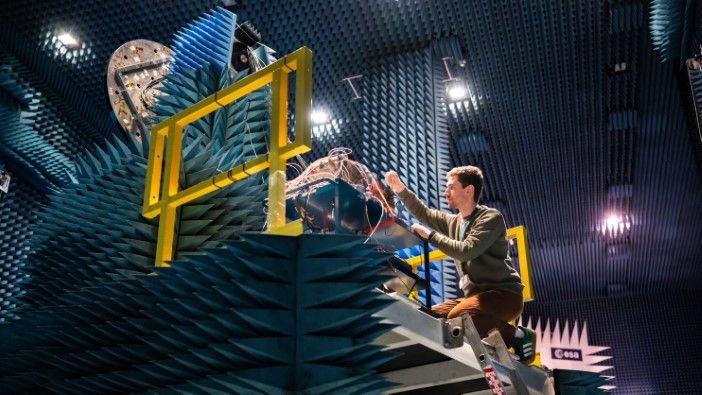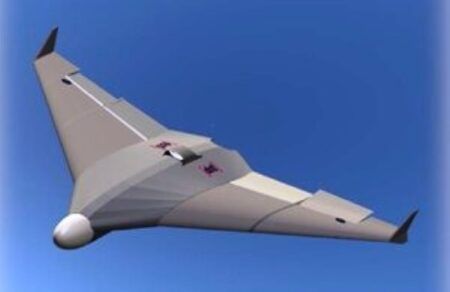Engineers from the European Space Agency’s Radio Frequency Equipment and Technology section have tested a new antenna able to focus multiple beams of signals in different desired directions, reducing the number of components such a system requires.
The radio beamforming technology, which was developed, patented and prototyped in-house at the European Space Agency’s (ESA’s) Microwave Laboratory and is being tested in ESA’s Antenna Laboratory.
The tests successfully demonstrated the new way of controlling radio signals in the antenna array by using natural geometrical symmetry of antennas and radio beams.
Antenna array technology developed
Instead of using a single high-power, mechanically steerable antenna modern systems employ a set of multiple, low-power antennas working together to steer the radio waves in desired directions – without pointing the antenna itself. Such ‘antenna arrays’ can contain hundreds or even thousands of individual antenna elements – each of them fed separately with signals generated by a beamformer, with precisely calculated timing.
Hugo Debergé, microwave engineer at the ESA said: “By changing the signal’s phase and amplitude for each individual element in an array, we can steer the resulting signal in a desired direction. We don’t do this by physically tilting the antenna, as we used to do, but instead by adjusting the electrical signals we feed into individual antenna elements.
“The new beamforming technology we are testing builds on two separate discoveries, both patented by ESA. The first one is a concept known for over 10 years – that if your antenna array is symmetrical (which is likely the case), you can treat symmetrical elements as couples and simplify the calculation of individual signals in a digital processor. By feeding each couple with signals that are complementary to each other, you will have the same functionality as if you were controlling them as two independent elements.”
If you think of an antenna as a clock face, then the elements located at 12 and 6 o’clock would form a couple, and the elements at 3 and 9 o’clock would form another. If we draw the line of symmetry going across the clock in a slightly different place, the 12 and 9 o’clock elements would form a couple, and the 3 and 6 o’clock elements would form another one.
“The second innovation, patented by ESA in 2023, focuses on the way the electrical signals for antenna couples are created by an electrical circuitry. We came up with a way to simplify the electrical circuit within the system so that it allows us to remove half the components and still maintain the same functionality – this is a major improvement, drastically reducing the overall complexity, mass and power consumption of the entire setup, while doing the exact same job,” said Debergé.
Performance testing
Antennas are fundamental for every spacecraft, allowing the transfer of communication or navigation signals – transmitting and receiving radar radio waves to observe planets, receiving scientific data from deep space or measuring altitude during entry descent and landing missions.
As with any spacecraft or instruments destined for space, a prototype like this one needs to be tested in an environment that recreates certain conditions found in space as closely as possible.
For antennas, this is done in anechoic chambers. The Hybrid European Radio Frequency and Antenna Test Zone (HERTZ), part of ESA’s Antenna Testing Facility at the European Space research and TEchnology Centre (ESTEC) in the Netherlands, is one such chamber.
“The concept demonstrated here in HERTZ is very convincing, but this is just the beginning,” Vaclav Valenta, microwave engineer and co-inventor at ESA of the concept said.
“This patented beamforming concept and associated experimental results are available to industries in ESA member states for space use, free of charge. They can integrate this solution into a single microchip that will allow for more compact and low-power solutions for both space and ground applications.
“Since the concept attracts a lot of attention among our industrial partners, a dedicated R&D program will be initiated soon to further increase the technology readiness. This will be implemented in the frame of an Open Space Innovation Platform (OSIP) call – a tool for the commercial maturation of ESA inventions,” concludes Vaclav.
ESA covers end-to end engineering capabilities from design and simulation to prototyping and testing. All this is done within one division team, allowing ESA engineers to quickly demonstrate new concepts. This suite of facilities is also available for industries and research institutes for their own R&D purposes.





